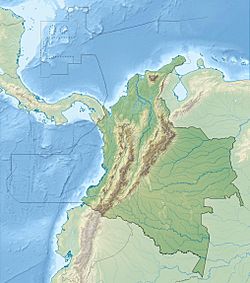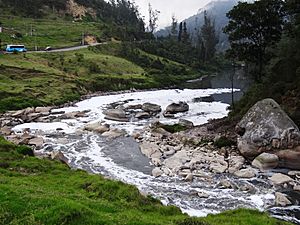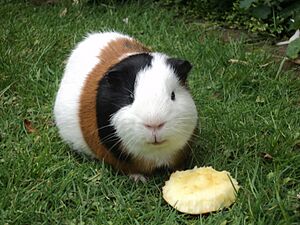Tequendama facts for kids
| Location | Soacha, Cundinamarca |
|---|---|
| Region | Altiplano Cundiboyacense, |
| Coordinates | 4°32′06.42″N 74°16′32.47″W / 4.5351167°N 74.2756861°W |
| Altitude | 2,570 m (8,432 ft) |
| Type | Cave, rock shelter |
| Part of | Pre-Muisca sites |
| History | |
| Abandoned | Colonial period (>1537) |
| Periods | Prehistory-Herrera-Muisca |
| Cultures | Herrera-Muisca |
| Site notes | |
| Archaeologists | Hammen, Correal |
| Public access | Yes |
Tequendama is an ancient archaeological site in Colombia. It is located southeast of Soacha, in the Cundinamarca region, near the famous Tequendama Falls. Scientists have found many signs that people lived here from a very long time ago, starting around 11,000 years ago.
This makes Tequendama one of the oldest places where humans lived in Colombia. Different groups lived here over time, including the Herrera and Muisca people. More recent signs of the Herrera people were also found nearby, dating from about 900 BCE to 900 AD.
Two important researchers, Thomas van der Hammen (a Dutch geologist) and Gonzalo Correal Urrego (an archaeologist), helped us learn a lot about Tequendama since 1969.
Contents
What Does Tequendama Mean?
The name Tequendama comes from the Muysccubun language. It means "he who falls downward" or "he who precipitates downward." This name likely refers to the nearby Tequendama Falls.
A Look Back in Time
Before the Spanish arrived in Colombia, the high plains of the Andes mountains were home to different groups of people. First, there were very early groups, then the Herrera people, and finally the Muisca.
Archaeologists have found many ancient sites in this area. Some of these include Tibitó, Aguazuque, Checua, El Abra, and of course, Tequendama. These sites help us understand how people lived thousands of years ago.
Exploring the Tequendama Site
The Tequendama site has four main areas where people lived. These are called Tequendama I, II, III, and IV. They are all caves or rock shelters very close to each other. People probably chose to live here because they had easy access to fresh water from the Bogotá River.
- Tequendama I: This is the oldest part, with signs of people living here from about 11,000 to 10,000 years ago.
- Tequendama II: People lived here from about 9,500 to 8,300 years ago.
- Tequendama III: This area was used from about 7,000 to 6,000 years ago.
- Tequendama IV: This is the most recent phase, from about 2,500 to 450 years ago. During this time, people started building structures inside the caves and under the rock overhangs. They also began using pottery. Some rock art found at Tequendama is from this period.
Around 2,000 years ago, people at Tequendama started to domesticate (tame) guinea pigs. This means they were raising them for food or other uses.
The people living at Tequendama were likely semi-nomadic hunter-gatherers. This means they moved around a bit to find food, but often returned to these shelters. Each group probably had up to 15 people. They ate fruits, land snails, deer, and small animals like rodents.
Archaeologists found areas where people made fires, along with hunting tools. They also found evidence of how food was prepared and eaten. Many of the tools were knives used for scraping. Outside the shelters, they found signs that people processed animal skins. All the waste was collected in a ditch.
Life in Tequendama I
Tequendama I is located at an altitude of about 2,570 meters (8,430 feet). The oldest dates show people lived here between 12,500 and 10,100 years ago. People continued to live in Tequendama I until about 5,000 years ago.
Scientists studied the tools and pollen found here to learn about the first inhabitants. Around 12,500 to 11,000 years ago, the climate was warmer and wetter than today.
Later, from 11,000 to 9,500 years ago, the climate became colder again. The glaciers in the Andes mountains grew. The people living on the high plains were hunter-gatherers. They mostly hunted white-tailed deer and brocket deer, which made up about 40% of the animal remains found. They also ate smaller animals like cotton rats, guinea pigs, and cottontail rabbits. Bones found were often broken, suggesting people ate the bone marrow and used bones for tools or decoration. Unlike another site called Tibitó, no bones of very large Ice Age animals (megafauna) were found at Tequendama.
After the colder period, around 10,000 or 9,500 years ago, the forests returned. More signs of rodents and fewer deer were found, showing a change in what people ate.
The tools found at Tequendama I were mainly made of chert (a type of rock). They were very carefully made, even more so than tools found at El Abra. More than half of the tools were simple knives.
After about 8,000 years ago, fewer people lived in the rock shelters. It seems they moved to the open plains of the Bogotá savanna.
Scientists also studied 20 bone samples from Tequendama. Most of them (60%) were from males. Children (20%) and women (15%) made up a smaller part of the remains. More than 95% of the bones were still complete. Evidence of funeral practices was also found. People traditionally buried bodies with their heads facing east.
Places Named After Tequendama
The name Tequendama is used for several places and things today:
- Tequendama Falls (Salto del Tequendama) - A 132-meter (433-foot) high waterfall on the Bogotá River.
- Tequendama Falls Museum - A museum and old hotel that overlooks the waterfall.
- Tequendama Province - The area or region around the falls.
- San Antonio del Tequendama - A town and the capital of the Tequendama Province.
- Hotel Tequendama - A famous hotel in the center of Bogotá.
See also
 In Spanish: Sitio arqueológico de Tequendama para niños
In Spanish: Sitio arqueológico de Tequendama para niños





